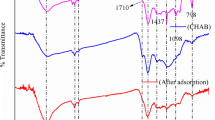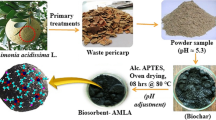Abstract
The present study aims to introduce a proficient and inexpensive adsorbent for eliminating fluoride from an aqueous medium. The defluoridation process was carried out by activated carbon derived from mango kernel (MKA), which is naturally available bio-waste. The adsorption process was first modeled by an artificial neural network (ANN) and then optimized through a genetic algorithm (GA). The concentration profile was also validated by computational fluid dynamics (CFD). Impacts of input parameters viz. contact duration, pH, temperature, adsorbent dose, and initial concentration on percent removal were observed. Surface morphologies, active surface area, presence of functional groups, etc. of MKA were characterized using BET, SEM, EDX, and FTIR, respectively. The engineered sorbent confirms excellent performance towards expulsion of fluoride ions with above 99% removal at an initial concentration of 9 mg/L, MKA dose of 0.3 g/L, temperature 25 °C, pH 5, and contact time of 18 h. The adsorption process was proved to be thermodynamically spontaneous and obeys pseudo-2nd-order kinetic and Freundlich isotherm model. Therefore, it can be concluded that MKA could be a promising precursor for developing adsorbents on the way to fluoride decontamination in an aqueous solution.








Similar content being viewed by others
Data availability
All data generated or analyzed during this study are included in this published article.
References
Abdel-Aty AM, Ammar NS et al (2013) Biosorption of cadmium and lead from aqueous solution by fresh water algae Anabaena spherica biomass. J Adv Res 4:367–374
Bhatnagar A, Kumar E, Sillanpaa M (2011) Fluoride removal from water by adsorption: a review. Chem Eng J 171(3):811–840
Bhattacharya HN, Chakrabarti S (2011) Incidence of fluoride in the groundwater of Purulia District, West Bengal: a geo-environmental appraisal. Curr Sci 101(2):152–155
Borgohain X, Boruah A, Sarma GK, Rashid MH (2020) Rapid and extremely high adsorption performance of porous MgO nanostructures for fluoride removal from water. J Mol Liquids 305:112799
Boruff CS (1934) Removal of fluorides from drinking water. Ind Eng Chem 26:69–71
Chowdhury S, Halder G, Mandal T, Sikder J (2019) Cetylpyridinium bromide assisted micellar-enhanced ultrafiltration for treating Enrofloxacin-laden water. Sci Total Environ 687:10–23
Chowdhury S, Sikder J, Mandal T, Halder G (2019) Comprehensive analysis on sorptive uptake of enrofloxacin by activated carbon derived from industrial paper sludge. Sci Total Environ 665:438–452
Chowdhury S, Lahiri SK, Hens A, Katiyar S (2021) Performance enhancement of commercial ethylene oxide reactor by artificial intelligence approach. Int J Chem React Eng. 000010151520200230. https://doi.org/10.1515/ijcre-2020-0230
Ghosh A, Mukherjee K, Ghosh SK, Saha B (2013) Sources and toxicity of fluoride in the environment. Res Chem Intermediat 39:2881–2915
Gupta VK, Jain R, Varshney S (2007) Removal of Reacto fix golden yellow 3 RFN from aqueous solution using wheat husk—an agricultural waste. J Hazard Mater 142:443–448
Halder GN, Sinha K, Dhawane S (2015) Defluoridation of wastewater using powdered activated carbon developed from Eichhornia crassipes stem: optimization by response surface methodology. Desalin Water Treat 56:953–966
Hameed BH (2009) Spent tea leaves: a new non-conventional and low-cost adsorbent for removal of basic dye from aqueous solutions. J Hazard Mater 161(2–3):753–759
Hatano K, Kikuchi S, Nakamura Y, Sakamoto H et al (2009) Novel strategy using an adsorbent-column chromatography for effective ethanol production from sugarcane or sugar beet molasses. Bioresour Technol 100(20):4697–4703
Kayan B, Gozmen B (2012) Degradation of Acid Red 274 using H2O2 in subcritical water: application of response surface methodology. J Hazard Mater 201:100–106
Lahiri SK, Chowdhury S, Hens A et al (2021) Modeling and multi-objective optimization of commercial ethylene oxide reactor to strike a delicate balance between profit and negative environmental impact. Environ Sci Pollut Res. https://doi.org/10.1007/s11356-021-12504-w
Liu Q, Guo H, Shan Y (2010) Adsorption of fluoride on synthetic siderite from aqueous solution. J Fluor Chem 131:635–641
Madera-Parra CA, Pena-Salamanca EJ, Pena MR, Rousseau DPL, Lens PNL (2015) Phytoremediation of landfill leachate with Colocasia esculenta, Gynerum sagittatum and Heliconia psittacorum in constructed wetlands. Int J Phytoremediat 17:16–24
Maged A, Ismael SI, Iqbal J, Kharbis S, Sarkar B, Peräniemi S, Bhatnagar A (2019) Enhanced interlayer trapping of Pb(II) ions within kaolinite layers: intercalation, characterization, and sorption studies. Environ Sci Pollut Res 27:1870–1887
Maged A, Dissanayake PD, Yang X, Pathirannahalage C, Bhatnagar A, Ok YS (2021) New mechanistic insight into rapid adsorption of pharmaceuticals from water utilizing activated biochar. Environ Res 202:111693
Michailof C, Stavropoulos GG, Costas Panayiotou C (2008) Enhanced adsorption of phenolic compounds, commonly encountered in olive mill wastewaters, on olive husk derived activated carbons. Bioresour Technol 99(14):6400–6408
Mohan SV, Ramanaiah SV, Rajkumar B, Sharma PN (2007) Biosorption of fluoride from aqueous phase onto algal Spirogyra IO1 and evaluation of adsorption kinetics. Bioresour Technol 98:1006–1011
Mukherjee S, Halder G (2016) Assessment of fluoride uptake performance of raw biomass and activated biochar of Colocasia esculenta stem: optimization through response surface methodology. Environ Prog Sustain Energy 35:1305–1316
Mukherjee S, Kamila B, Paul S, Hazra B, Chowdhury S, Halder G (2020a) Optimizing fluoride uptake influencing parameters of paper industry waste derived activated carbon. Microchem J 160:105643. https://doi.org/10.1016/j.microc.2020.105643
Mukherjee S, Khan AA, Barman S, Halder G (2020b) Experimental study of biosorption of fluoride by immobilized beads of zeoliteNaA and Nostoc sp.(BTA394) using a continuous flow system. Environ Progress Sustain Energy: e13465. https://doi.org/10.1002/ep.13465
Rai MK, Shahi G et al (2016) Removal of hexavalent chromium Cr (VI) using activated carbon prepared from mango kernel activated with H3PO4. Resource-Efficient Technol 2:S63–S70
Ramanaiah SV, Venkata Mohan S, Sarma PN (2007) Adsorptive removal of fluoride from aqueous phase using waste fungus (Pleurotus ostreatus 1804) biosorbent: kinetics evaluation. Ecol Eng 31:47–56
Saha S (1993) Treatment of aqueous effluent for fluoride removal. Water Resour 27:1347–1350
Sakhare N, Lunge S et al (2012) Defluoridation of water using calcium aluminate material. Chem Eng J 203:406–414
Samanta S, Chowdhury S, DasSharma D, Halder G (2020) The biosorptive uptake of enrofloxacin from synthetically produced contaminated water by tamarind seed derived activated carbon. RSC Adv 10:1204–1218
Sar A, Uluozlu OD, Tuzen M (2011) Equilibrium, thermodynamic and kinetic investigations on biosorption of arsenic from aqueous solution by algae (Maugeotia genuflexa) biomass. Chem Eng J 167:155–161
Sepehr MN, Kazemian H, Ghahramani E, Amrane A, Sivasankar V, Zarrabi MJ (2014) Defluoridation of water via light weight expanded clay aggregate (LECA): adsorbent characterization, competing ions, chemical regeneration, equilibrium and kinetic modelling. J Taiwan I Chem Eng 45(4):1821–1834
Somayajula A, Aziz AA, Saravanan P, Matheswaran M (2013) Adsorption of mercury (II) ion from aqueous solution using low-cost activated carbon prepared from mango kernel. Asia-Pac J Chem Eng 8(1):1–10
Subba Rao N (2003) Groundwater quality: focus on fluoride concentration in rural parts of Guntur district, Andhra Pradesh, India. Hydrol Sci J Sci Hydrol 48(5):835–847
Sun Y, Fang Q, Dong J, Cheng X, Xu J (2011) Removal of fluoride from drinking water by natural stilbite zeolite modified with Fe(III). Desalination 277:121–127
Suthar S, Garg VK, Jangir S et al (2008) Fluoride contamination in drinking water in rural habitations of Northern Rajasthan. India Environ Monit Assess 145:1–6
Thakkar M, Wu Z, Wei L, Mitra, (2015) Water defluoridation using a nanostructured diatom–ZrO2 composite synthesized from algal biomass. J Colloid Interface Sci 450:239–245
Thakre PN, Mukherjee S, Samanta S, Barman S, Halder G (2020) A mechanistic insight into defluoridation of simulated wastewater applying bio-inspired sodium alginate bead. Appl Water Sci 10:65
WHO (2006) Chemical fact sheets: fluoride, guidelines for drinking water quality (electronic resource) 3rd edition. Incorporation First Addendum, Recommendations, Geneva 2006, 375–377
Yalcin M, Gurses A, Dogar C, Sozbilir M (2004) The adsorption kinetics of cethyl tri methyl ammonium bromide (CTAB) onto powdered activated carbon. Adsorp 10:339–348
Acknowledgements
Authors convey their gratitude to Department of Chemical Engineering, National Institute of Technology Durgapur, West Bengal and University of Calcutta, West Bengal for extending technical facilities.
Author information
Authors and Affiliations
Contributions
Conceptualization: Shraboni Mukherjee; investigation: Sayanta Paul; data curation: Baisakhi Hazra; writing—original draft preparation: Biswajit Kamila; formal analysis and validation: Somnath Chowdhury; writing—reviewing and editing: Raj Kumar Arya, Sanghamitra Barman and Gopinath Halder.
Corresponding author
Ethics declarations
Competing interests
The authors declare no competing interests.
Additional information
Publisher's note
Springer Nature remains neutral with regard to jurisdictional claims in published maps and institutional affiliations.
Rights and permissions
About this article
Cite this article
Mukherjee, S., Kamila, B., Paul, S. et al. Insight into biosorptive uptake of fluoride by chemically activated biochar: experimental modeling and parametric optimization. Biomass Conv. Bioref. 13, 16753–16764 (2023). https://doi.org/10.1007/s13399-021-02200-7
Received:
Revised:
Accepted:
Published:
Issue Date:
DOI: https://doi.org/10.1007/s13399-021-02200-7




